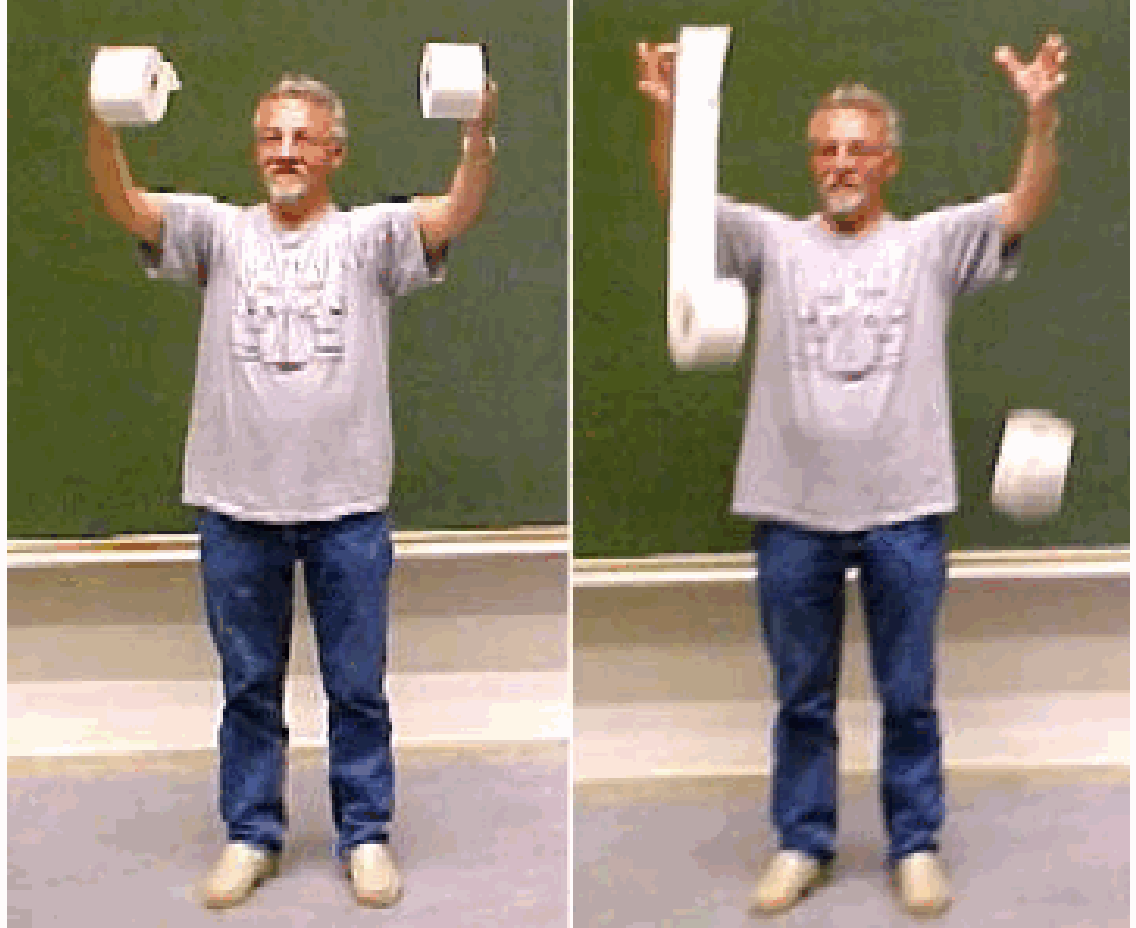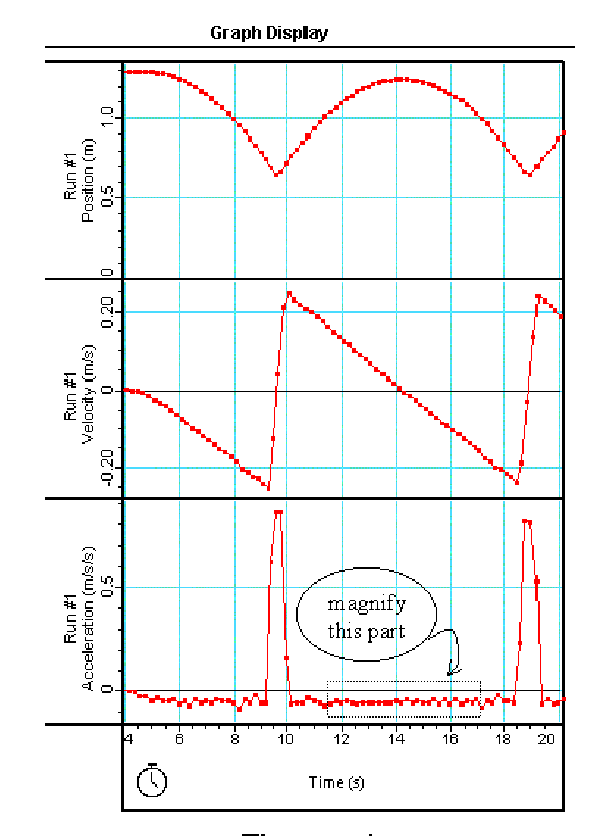06 Rolling Downhill#
Aim#
To show, qualitatively, the influence of the moment of inertia in rolling downhill.
Subjects#
1Q10 (Momentum of Inertia)
1Q20 (Rotational Energy)
Diagram#

Fig. 208 .#
Equipment#
Inclined ramp ( \(l=2 \mathrm{~m}\); we use a flat door).
Rolling objects
\(m_{1}\) cilinder of wood with lead in the center ( \(\varnothing 60 \mathrm{~mm} ; m=424 \mathrm{~g}\) ); \(C=0.21\)
\(m_{2}\) solid aluminum cilinder ( \(\varnothing 60 \mathrm{~mm} ; m=424 \mathrm{~g}\) ) \(C=0.5\)
\(m_{3}\) hollow brass cilinder ( \(\varnothing 60 \mathrm{~mm}, \mathrm{~d}=5 \mathrm{~mm} ; m=424 \mathrm{~g}\) ); \(C=0,83\)
\(m_{4}\) solid brass cilinder ( \(\varnothing 60 \mathrm{~mm} ; m=1.3 \mathrm{~kg}\) ); \(C=0,5\)
\(m_{5}\) solid aluminum cilinder ( \(\varnothing 120 \mathrm{~mm} ; m=1.7 \mathrm{~kg}\) ); \(C=0,5\)
\(m_{6}\) steel ball \((\varnothing 40 \mathrm{~mm} ; m=230 \mathrm{~g}) ; C=0,4\)
\(m_{7}\) ping pong ball ( \(\varnothing 37.5 \mathrm{~mm} ; m=2 \mathrm{g}\) ); \(C=0,67\)
\(m_{8}\) basketball; \(C=0.67\)
Overhead sheet with list of moments of inertia of rolling objects.
Balance with large display.
Presentation#
Preparation#
The ramp has to be adjusted horizontally in its cross direction, using an air-level. The two clamps (see Diagram B) are placed in such a way that in starting, the shelf, while pressed against these clamps, is nicely perpendicular to the long side of the ramp. A heavy wooden beam keeps the ramp at the end of the table. This beam also stops the rolling objects.
Presentation.#
Different races are presented to the students. Before each race, the mass of the racing objects is determined by placing each object on the balance. Then students are asked to predict the result of that race: Is there a winner/loser? When the answer is yes, which object will be the winner/loser?
Race 1:
\(m_{1}, m_{2}\) and \(m_{3}\) race down the ramp together, starting at the same time. \(m_{1}\) is the winner, \(m_{3}\) the loser. (Most students predict the right answer. Evidently the distribution of mass is important.)
Race 2:
\(m_{2}\) and \(m_{4}\) race down the ramp together. There is no winner. (Most students predict the wrong answer. Evidently mass is not important in this demonstration. It makes me remember Galileo dropping objects from the tower of Pisa, in which experiment mass has also no influence on the downward acceleration.)
Race 3:
\(m_{2}\), \(m_{4}\) and \(m_{5}\) race down the ramp together. They arrive together; there is no winner. (Many students don’t dare to predict. Evidently radius \(R\) is of no importance in this experiment.)
Now an overhead sheet is presented to the students that shows a table of the expressions of moments of inertia of the various rolling objects. When mass \(m\) and radius \(R\) are of no importance in these downhill races then the difference will be found in the factor ahead of \(m R^{2}\) in the expressions of the moment of inertia. After this observation the next races will be predicted right by (almost) all students.
Race 4:
\(m_{2}, m_{6}\) and \(m_{7} . m_{6}\) is the winner, \(m_{7}\) the loser.
Figure 209 shows a summary. ‘

Fig. 209 .#
Explanation#
Rolling down means translational acceleration plus rotational acceleration. The more energy is needed for rotational acceleration, the less energy is left for translational acceleration.
Conservation of energy tells us: \(1 / 2 m v_{c}^{2}+1 / 2 I \omega^{2}+m g h=\) constant.
By \(v_{c}=\omega R, h=s \sin \gamma\) and differentiating, we find \(a_{c}=\frac{g \sin \gamma}{1+\frac{I_{c}}{m R^{2}}}\)
The moment of inertia of objects with circular symmetry can be written as: \(I=C m R^{2}\), where \(C\) is a constant. From tables we know (see Figure 209):
solid sphere, \(C=2 / 5\)
solid cilinder, \(C=1 / 2\)
hollow sphere, \(C=2 / 3\)
hollow cilinder, \(C=1\)
cilinder with thickness \(\left(R_{2}-R_{1}\right), C=\frac{1}{2}\left(1+\left(\frac{R_{1}}{R_{2}}\right)^{2}\right)\)
Using \(C\) in the expression above, we find: \(a_{c}=\frac{g \sin \gamma}{1+C}\)
The larger \(C\), the smaller \(a_{c}\). Also note that \(a_{c}\) does not depend on \(m\) or \(R\)!
Remarks#
To have a fair race you need to have a good starting procedure. We get the best start by using a shelf, blocking the objects in the starting position. Starting is done by very quickly moving the shelf away into the direction of the descending ramp.
When racing the basketball and ping pong ball (Race 5) there is no winner. Makes sure that in starting, the basketball is not ahead of the ping pong ball.
Sources#
Jewett Jr., John W., Physics Begins With Another M… : Mysteries, Magic, Myth, and Modern Physics, pag. 113-114
Young, H.D. and Freeman, R.A., University Physics, pag. 304
Giancoli, D.G., Physics for scientists and engineers with modern physics, pag. 263
